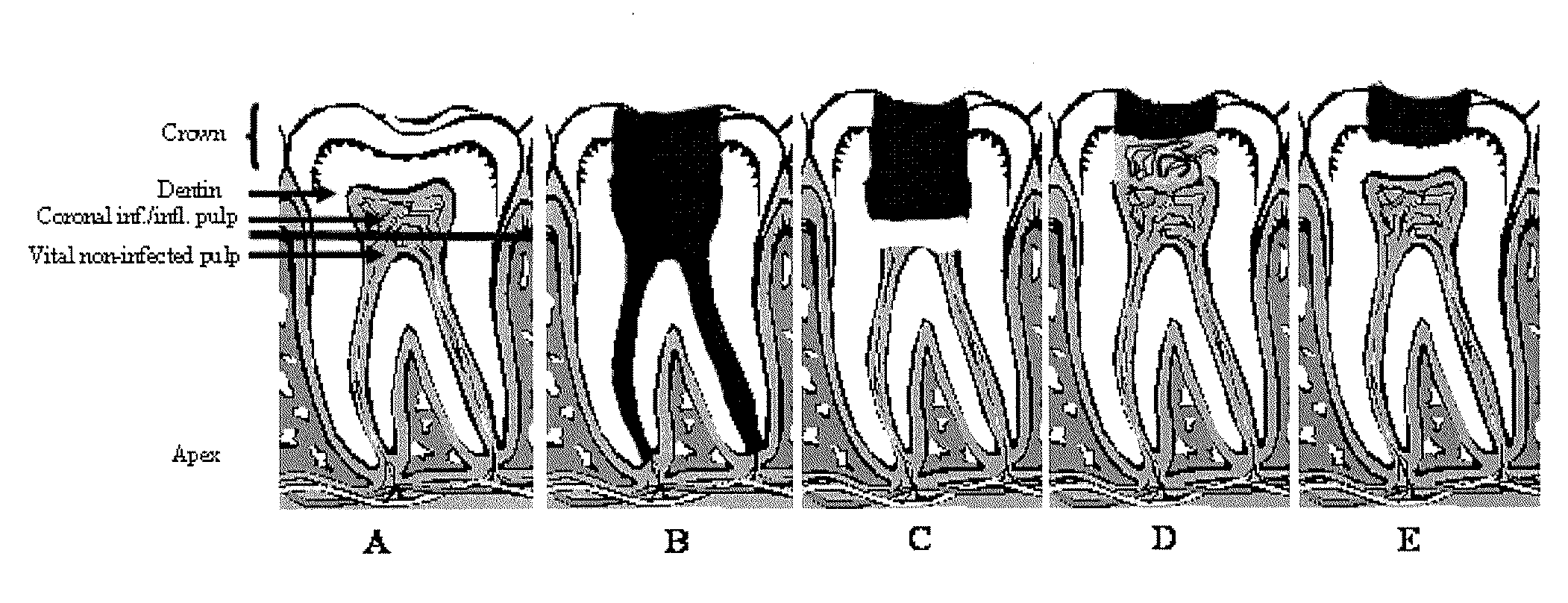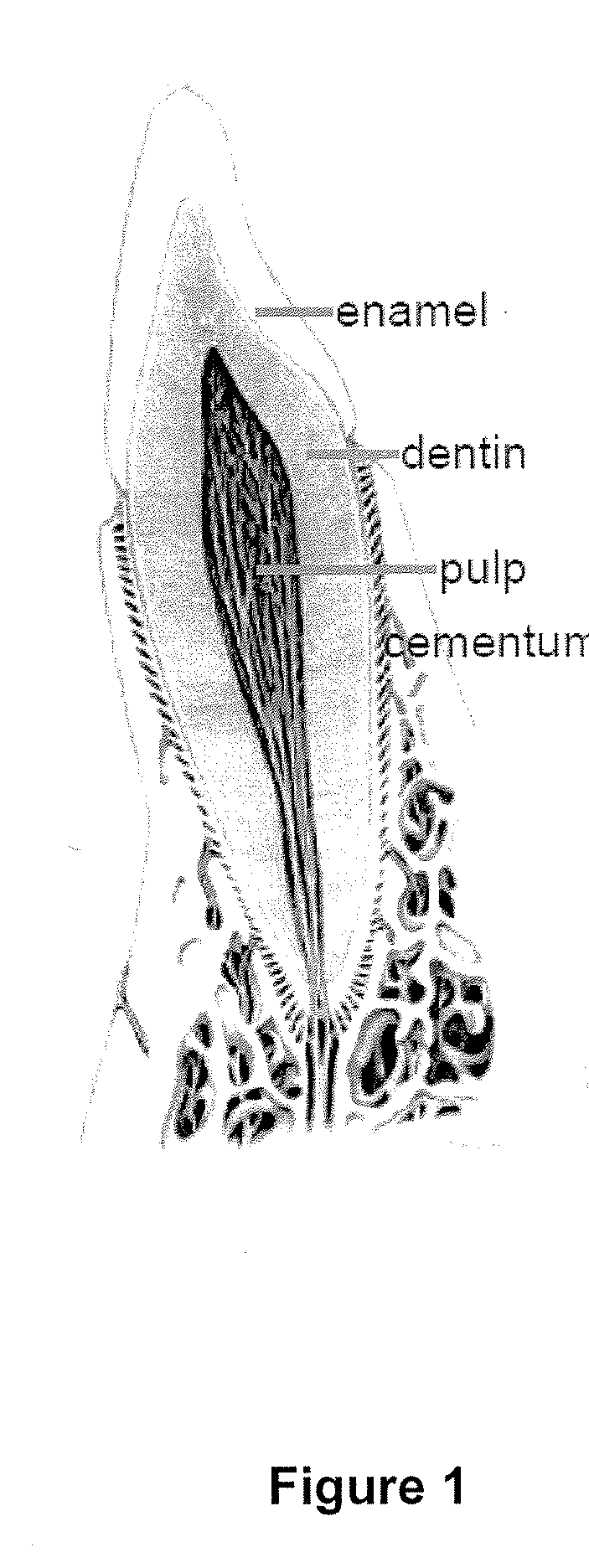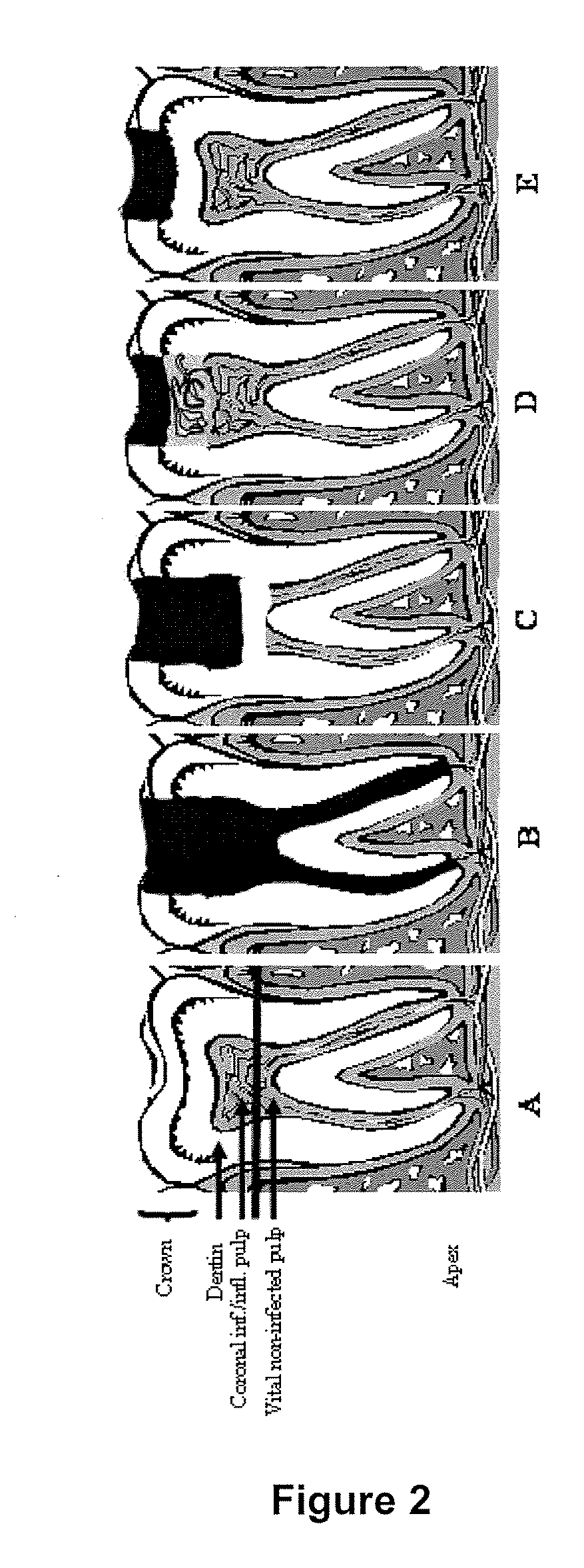Compositions and methods for treating pulp inflammations caused by infection or trauma
a technology of pulp inflammation and composition, applied in the direction of biocide, instruments, skeletal/connective tissue cells, etc., can solve the problems of permanent loss of tooth vitality, no treatment form aimed at regaining pulp space lost to inflammation
- Summary
- Abstract
- Description
- Claims
- Application Information
AI Technical Summary
Benefits of technology
Problems solved by technology
Method used
Image
Examples
example 1
Establishment of Pulp Fibroblast Cultures
[0210]A protocol for establishing human pulp cells from explant outgrowth has been developed and is described herein. For preliminary purposes, the outgrowth of porcine pulp tissue was investigated. A suitable porcine model for developing pulp cultures is useful for preliminary trials and for comparison to human pulp tissue.
[0211]The methods were used for explanting human pulp tissue and culturing such tissue for outgrowth and subsequent culturing of cells. Porcine pulp fibroblasts were observed to grow faster than human pulp cells and their attachment morphology was slightly different from those of human origin. Initial and continued explant attachment to the culture flask surface was critical for outgrowth to occur. Contrary to other soft tissues, pulp explants that floated in culture medium did not produce cells. Explant pieces that became dislodged were removed from the flask and reattached to the bottom of another flask. Such reattached ...
example 2
Collagen and Alginate Gel Fabrication and Cell Embedding
[0212]Human pulp cells were embedded and grown in type I collagen gel for 6 weeks as described herein. To prepare a matrix containing pulp cells and collagen, 1.5 ml of cell suspension (3.1×106 cells / ml) in DMEM was mixed on ice with 5.0 ml of 3.1 mg / ml collagen solution (Vitrogen, Palo Alto, Calif.), 0.5 ml HEPES (25 mM) and 0.5 ml DMEM to a final concentration of 2.0 mg / ml of collagen in the collagen-cell solution. Collagen-cell solution was poured into the wells of a 6 well culture plate. The plate was incubated for 2 hours at 37° C. After polymerization, the culture media (Dulbecco's Modified Eagle's Medium (DMEM) supplemented with 10% fetal bovine serum (FBS), 100 UI / mL penicillin and 100 μg streptomycin and 5% non-essential amino acids) and the media was changed every two days. After 14 days these unrestrained gels containing cells exhibited noticeable contraction and became detached from the well surfaces. After 40 days,...
example 3
Mechanical Properties of Porcine Pulp Tissue
[0215]An unconfined compression testing apparatus (of a type that can be used for cartilage explant testing) was used (Mauck et al, 2000) to test hydrogel mechanical properties. Porcine tissue was used as a testing tissue as it is relatively readily available compared to human pulp tissue. For the testing, the sample was cut into a 4×4×2 mm section, with the 2 mm axis in the buccal-lingual direction. A tare load of 2 g was applied. With a ramp speed of 1 μm / s, deformations of 10% and 20% were applied. For each deformation stress-relaxation curves (force vs time) were recorded utilizing a 50 g load cell. The equilibrium modulus was determined for each applied deformation. The measured modulus was calculated to be 1.3 kPa. Previous estimates of pulp properties in the dental finite element literature include 0 Mpa (megapascals) (Thresher, 1973), 0.003 (Toparli et al, 1999), and 3 Mpa (Williams et al, 1984). An increased sensitivity can be gai...
PUM
| Property | Measurement | Unit |
|---|---|---|
| concentration | aaaaa | aaaaa |
| concentration | aaaaa | aaaaa |
| concentration | aaaaa | aaaaa |
Abstract
Description
Claims
Application Information
 Login to View More
Login to View More - R&D
- Intellectual Property
- Life Sciences
- Materials
- Tech Scout
- Unparalleled Data Quality
- Higher Quality Content
- 60% Fewer Hallucinations
Browse by: Latest US Patents, China's latest patents, Technical Efficacy Thesaurus, Application Domain, Technology Topic, Popular Technical Reports.
© 2025 PatSnap. All rights reserved.Legal|Privacy policy|Modern Slavery Act Transparency Statement|Sitemap|About US| Contact US: help@patsnap.com



